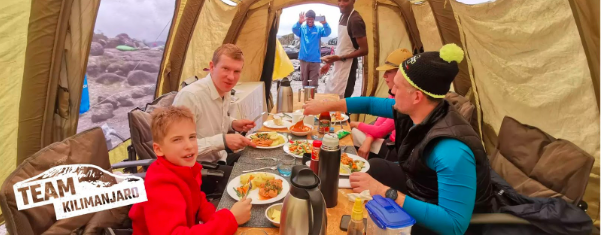The world’s great journeys are not only about where they take you but how they make you feel along the way. To climb Kilimanjaro, Africa’s highest mountain at 5,895 metres, is one of those rare experiences where physical challenge and refined living meet in surprising harmony.
It is a trek through rainforest, alpine desert, and icy summit — but also a culinary and cultural journey. Thanks to operators like Team Kilimanjaro, food and comfort become an integral part of the expedition, ensuring that the climb is not just a test of endurance but an immersion in fine dining at altitude.
How Long Does It Take?
Much like a well-paced tasting menu, timing matters. Many climbers ask how long does it take to climb Kilimanjaro. While the mountain can technically be climbed in as little as five days, success rates are far higher when spread across seven to nine days. This gives the body time to acclimatise — a reminder that the most exquisite experiences cannot be rushed.
Team Kilimanjaro’s TK Lemosho Route is a particularly refined option. Unlike crowded alternatives such as Machame and Umbwe, it avoids wasted ascents and keeps the progression elegant and balanced. For those who wish to savour something unique, the “Excel Extension” offers a night in the summit crater at 5,729 metres, a once-in-a-lifetime indulgence few ever experience.
The Dining Experience on the Mountain
For most, the idea of dining at 4,000 metres conjures images of freeze-dried meals eaten hunched in a tent. On Kilimanjaro, however, fine dining principles are applied even here. In Team Kilimanjaro’s Advantage Series — chosen by about 70% of trekkers — climbers sit at tables with chairs and enjoy freshly prepared three-course meals: hot soups to start, mains such as grilled chicken or rich stews with rice and vegetables, followed by fruit or even cake for dessert.
Meals are designed not just for calories, but for comfort and morale. The ritual of gathering in a mess tent, with the table neatly set, creates the atmosphere of a private dining club high on the slopes of the mountain.
For those who prefer exclusivity, the Hemingway Series offers the most refined experience: VIP-level service, premium comfort, and cuisine to match. It transforms the climb from an outdoor expedition into a luxury adventure, where every detail — from the tableware to the presentation of a meal — feels curated.
At the other end of the spectrum, the Superlite Series is akin to foraging: climbers carry their own supplies, choosing simplicity over indulgence. The beauty of Kilimanjaro lies in offering all these interpretations, much like the culinary world accommodates both Michelin-starred menus and street food artistry.
Timing the Season
Seasonality, so central to fine dining, is equally vital on Kilimanjaro. The best time to climb Kilimanjaro is during the dry months of January to March and June to October. These months are the equivalent of peak harvest seasons: the conditions are stable, skies are clear, and the “ingredients” of the climb — scenery, safety, and summit success — are at their best.
The rainy months (April–May and November) add complexity. Trails are muddy, skies cloudier, and meals are served in wetter conditions. Yet just as some chefs delight in working with challenging seasonal ingredients, some climbers enjoy the quieter, greener atmosphere of these months.
Preparing for the Gourmet Trek
Training for Kilimanjaro resembles preparing for a long, multi-course dinner: endurance and pacing are key. Climbers spend months beforehand building stamina with hikes and cardio training, much like chefs perfecting mise en place before service.
Packing also reflects the range of environments: breathable clothing for rainforest humidity, insulated layers for summit frost. And, importantly, an appetite for both food and experience. Hydration and nutrition are critical; chefs and guides alike know that flavour and function go hand in hand.
The Summit Course
The final push to Uhuru Peak begins at midnight, under starlight. It is the “main course” of the expedition: long, testing, and unforgettable. After six to eight hours of steady ascent, dawn breaks across the glaciers, painting them pink and gold. The reward is not only the view but the knowledge that each preceding “course” — the preparation, the meals, the camaraderie — brought you here.
Many climbers describe their first sip of tea or bite of breakfast after summiting as one of the most delicious moments of their lives, proof that context is the ultimate seasoning.
Beyond the Summit
A true gourmet adventure extends beyond a single dish. Many climbers add a Serengeti safari or a few days on Zanzibar’s spice-rich shores. These extensions are the dessert course: a way to round off the climb with flavours and experiences as rich as the journey itself.
Final Reflection
To Kilimanjaro veterans, the mountain is both a challenge and a feast. With the right operator, it becomes a journey where fine dining principles — timing, balance, presentation — are carried to one of the most extraordinary settings on earth.
By choosing wisely — knowing how long does it take to climb Kilimanjaro, selecting the best time to climb Kilimanjaro, and embracing the TK Lemosho Route — the expedition transforms into something far beyond trekking. It becomes a gourmet narrative: a story of endurance flavoured with elegance, and of cuisine served at the roof of Africa.







